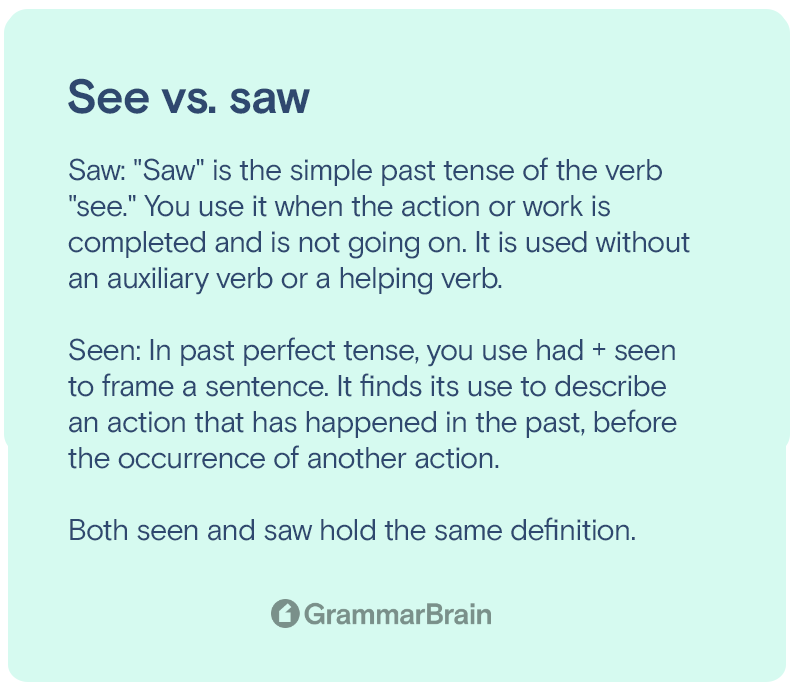What is the difference between “seen” and “saw?” Seen and saw are respectively, the past participle and simple past tense forms of the irregular verb “see.” The word “see” is an irregular verb. To “see” means to make a note of something by using your eyes.
Differences between “seen” and “saw”
Synonyms– looked, noticed, observed, sighted, spied, viewed, witnessed, viewed, discovered, realized.
Antonyms– ignored, passed over, overlooked, missed, disregarded.
Usage of “saw” in sentences
“Saw” is the simple past tense of the verb “see.” You use it when the action or work is completed and is not going on. It is used without an auxiliary verb or a helping verb. See the examples to see how to use it in the simple past tense form.
- I saw seven tigers in the zoo yesterday.
- She saw the police taking away a thief last week.
- You saw a snake eat a rat on the roadside.
Usage of “seen” in sentences
Since seen is the past participle form of the verb see – it needs auxiliary verbs like has, have, or had to form sentences, while saw is a standalone verb. It is the main difference to remember when using seen and seen.
Seen is used in both present perfect tense and past perfect tense. Do not get overwhelmed by the terms used if you do not know them. The examples will show that it is pretty simple.
- I have seen 15 cities across the United States.
- I have seen more things than I can count.
- We’ve seen the city, let’s get out of town.
| Word | Definition |
| Seen (verb) | past participle of see. |
| Saw (past tense) | perceive with the eyes; discern visually. |
What is an irregular verb?
You will observe that you get the past tense or past participle forms of many verbs by adding d or ed to the root word. These are regular verbs.
For example, the past tense of smile is smiled, like is liked, and create is created. We have added ‘d’ to the root word to get the past tense form. The past tense of play is played, clean is cleaned, and brush is brushed, where we have added ed to the root word to get the past tense.
Any verb that does not follow this pattern is called an irregular verb. We do not add d or ed to the verb see to get the past or participle form. Other irregular verbs are drink, sing, eat, etc.

Using “seen” in the present perfect tense
In the present perfect form, you use the helping verbs, has or have + seen, to frame sentences.
Remember, in this tense form, you do not use a specific time when the event happened.
Or you use it if the action continues to happen till the present.
- He has seen the movie twice. (Specific time is not mentioned in the sentence)
- I have seen one or the other exhibition on the palace grounds always. (Action continues to happen in the present)
Using “seen” in the past perfect tense
In past perfect tense, you use had + seen to frame a sentence. It finds its use to describe an action that has happened in the past, before the occurrence of another action.
You had seen me dancing on the terrace before the program began. (Here, both actions happened and got completed in the past.)
Conclusion
Saw and seen are the different forms of the verb see.
Saw is used in simple past tense and does not need helping verbs.
Seen is used in the past and present perfect tense and always needs a helping verb in a sentence.
FAQs
Is it “I seen” or “I saw?”
Is it “I have seen” or “I have saw?”
The correct phrase would be, “I have seen.” For example, “I have seen 15 cities across the United States.”
Inside this article
Fact checked:
Content is rigorously reviewed by a team of qualified and experienced fact checkers. Fact checkers review articles for factual accuracy, relevance, and timeliness. Learn more.
Core lessons
Glossary
- Abstract Noun
- Accusative Case
- Anecdote
- Antonym
- Active Sentence
- Adverb
- Adjective
- Allegory
- Alliteration
- Adjective Clause
- Adjective Phrase
- Ampersand
- Anastrophe
- Adverbial Clause
- Appositive Phrase
- Clause
- Compound Adjective
- Complex Sentence
- Compound Words
- Compound Predicate
- Common Noun
- Comparative Adjective
- Comparative and Superlative
- Compound Noun
- Compound Subject
- Compound Sentence
- Copular Verb
- Collective Noun
- Colloquialism
- Conciseness
- Consonance
- Conditional
- Concrete Noun
- Conjunction
- Conjugation
- Conditional Sentence
- Comma Splice
- Correlative Conjunction
- Coordinating Conjunction
- Coordinate Adjective
- Cumulative Adjective
- Dative Case
- Determiner
- Declarative Sentence
- Declarative Statement
- Direct Object Pronoun
- Direct Object
- Diction
- Diphthong
- Dangling Modifier
- Demonstrative Pronoun
- Demonstrative Adjective
- Direct Characterization
- Definite Article
- Doublespeak
- False Dilemma Fallacy
- Future Perfect Progressive
- Future Simple
- Future Perfect Continuous
- Future Perfect
- First Conditional
- Irregular Adjective
- Irregular Verb
- Imperative Sentence
- Indefinite Article
- Intransitive Verb
- Introductory Phrase
- Indefinite Pronoun
- Indirect Characterization
- Interrogative Sentence
- Intensive Pronoun
- Inanimate Object
- Indefinite Tense
- Infinitive Phrase
- Interjection
- Intensifier
- Infinitive
- Indicative Mood
- Participle
- Parallelism
- Prepositional Phrase
- Past Simple Tense
- Past Continuous Tense
- Past Perfect Tense
- Past Progressive Tense
- Present Simple Tense
- Present Perfect Tense
- Personal Pronoun
- Personification
- Persuasive Writing
- Parallel Structure
- Phrasal Verb
- Predicate Adjective
- Predicate Nominative
- Phonetic Language
- Plural Noun
- Punctuation
- Punctuation Marks
- Preposition
- Preposition of Place
- Parts of Speech
- Possessive Adjective
- Possessive Determiner
- Possessive Case
- Possessive Noun
- Proper Adjective
- Proper Noun
- Present Participle
- Prefix
- Predicate



